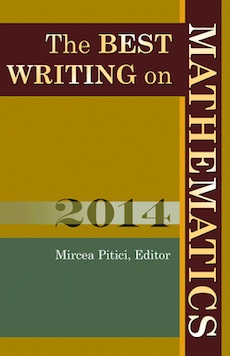By Douglas Whitaker
The curious reader who has a casual interest in mathematics is faced with a bewildering selection of wonderful, popular mathematics books. These books attempt to distill some aspect of mathematics or mathematicians – whether it is the applicability of mathematical lessons to everyday life, histories of mathematical concepts dating back millennia, or the passion with which some mathematicians pursued the subject – and are written in a way that presuppose little or no mathematical knowledge. The Best Writing on Mathematics 2014 is not one of these books. And that’s a good thing.
Mircea Pitici has instead edited a volume that addresses a different audience: people interested in mathematics who have a strong(er) mathematics background. The Best Writing on Mathematics 2014, the latest entry in this series, is a collection of twenty-four journal articles about mathematics, broadly defined, that were published in 2013. In the introduction, Pitici is clear about the aim of the book: “writings about mathematics are spread wide and thin, in venues less frequented by mathematicians; my goal is to find what is notable in that literature and make it easy for people to read it.”
The result of Pitici’s effort is “a deliberate medley of styles, sources, and perspectives.” By and large, however, the articles are written by academics, for academics. Readers will find that many of the articles are accessible to the general public, although this may not have been an intentional choice by the authors. Other articles are written for specific audiences that share an implicit professional language with the author. However, none of the articles is a traditional mathematical proof that would appear in a mathematics journal. Instead, the articles are chosen from academic journals associated with education, statistics, and the arts, as well as publications with a broader audience.
Specific topics that are represented among the articles include examples of mathematical statements which can neither be proven nor disproven, classifying and knitting Klein bottles, mathematical uses of food in classrooms, analogies that are helpful for teaching statistics, space-filling curves, computing Julia sets, and Big Data. Often, the articles assume the reader is at least vaguely familiar with the basics of the topic at hand. Because they are so diverse, it is doubtful that any particular reader will be overly enthusiastic about every article. Instead, a broad swath of mathematical topics ensures that every reader can engage with at least a few articles.
Readers do not need a degree in mathematics to understand and appreciate many articles in this volume, but having experience with advanced mathematical topics would certainly be a boon. Without at least a few proof-based undergraduate mathematics courses, readers may not be able to draw connections across the articles or have enough stores of background knowledge to engage deeply with this work.
Because the book’s scope extends only to articles published in the previous calendar year, the articles which can be considered for selection are necessarily limited. Pitici selects the final articles after considering feedback from independent reviewers and accounting for logistical issues such as article length and republication fees. Beyond the two dozen articles included in this book, Pitici lists scores of books and articles for interested readers seeking more; this is an excellent, if not overwhelming, addition.
The final presentation of the articles left me wanting more insight into why these specific articles were chosen. There is evidence of intentionality in the layout of the book with two articles about Klein bottles published together and several, but not all, articles with an educational context published together. Biographical sketches of all contributors are included at the end of the book, and I discovered that reading these before each article was helpful for placing the article in a context. Similarly, the original publication information for each article is listed on the last page of the book; because of my familiarity with some of the journals, I found this information helpful. To catapult The Best Writing on Mathematics series from great to outstanding, the editors might consider including single-page descriptions to help the reader place the article in context and understand why the article can be considered ‘best.’
When push comes to shove, The Best Writing on Mathematics 2014 does not shy away from mathematics, and that is why it shines. Pitici has done a wonderful job curating articles that form a cohesive, though not perfect, volume for readers seeking more than what popular mathematics books have to offer. Overall, this is a great book for the mathematically-experienced reader seeking to connect to mathematics outside of the world of textbooks and tests.
Douglas Whitaker (ΦBK, University of Florida, 2010) is a doctoral student specializing in statistics education at the University of Florida. The University of Florida is home to the Beta of Florida Chapter of Phi Beta Kappa.




